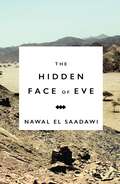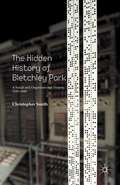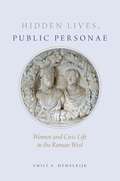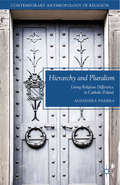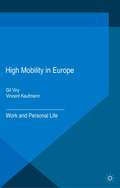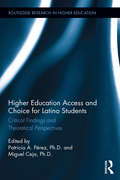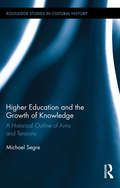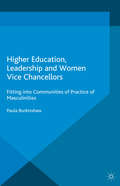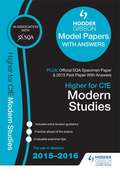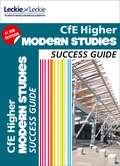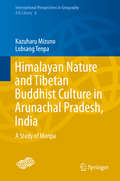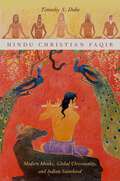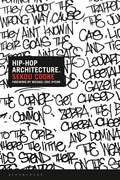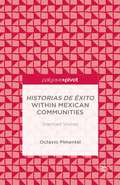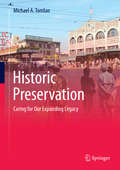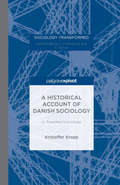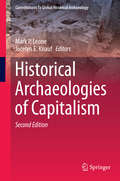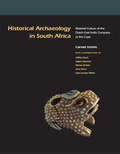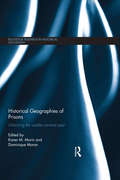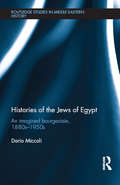- Table View
- List View
The Hidden Face of Eve: Women in the Arab World
by Nawal El SaadawiThis powerful non-fiction account of the oppression of women in the Muslim world remains as shocking today as when it was first published, more than a quarter of a century ago.Nawal El Saadawi writes out of a powerful sense of the violence and injustice which permeated her society. Her experiences working as a doctor in villages around Egypt, witnessing prostitution, honour killings and sexual abuse, including female circumcision, drove her to give voice to this suffering. She goes on to explore the causes of the situation through a discussion of the historical role of Arab women in religion and literature. Saadawi argues that the veil, polygamy and legal inequality are incompatible with the essence of Islam or any human faith.The Hidden Face of Eve remains a classic of modern Arab writing.
The Hidden History of Bletchley Park: A Social and Organisational History, 1939–1945
by C. SmithThis book is a 'hidden' history of Bletchley Park during the Second World War, which explores the agency from a social and gendered perspective. It examines themes such as: the experience of wartime staff members; the town in which the agency was situated; and the cultural influences on the wartime evolution of the agency.
Hidden Lives, Public Personae: Women and Civic Life in the Roman West
by Emily HemelrijkRoman cities have rarely been studied from the perspective of women, and studies of Roman women mainly focus on the city of Rome. Studying the civic participation of women in the towns of Italy outside Rome and in the numerous cities of the Latin-speaking provinces of the Roman Empire, this books offers a new view on Roman women and urban society in the Roman Principate. Drawing on epigraphy and archaeology, and to a lesser extent on legal and literary texts, women's civic roles as priestesses, benefactresses and patronesses or 'mothers' of cities and associations (collegia and the Augustales) are brought to the fore. In contrast to the city of Rome, which was dominated by the imperial family, wealthy women in the local Italian and provincial towns had ample opportunity to leave their mark on the city. Their motives to spend their money, time and energy for the benefit of their cities and the rewards their contributions earned them take centre stage. Assessing the meaning and significance of their contributions for themselves and their families and for the cities that enjoyed them, the book presents a new and detailed view of the role of women and gender in Roman urban life.
Hierarchy and Pluralism: Living Religious Difference in Catholic Poland (Contemporary Anthropology of Religion)
by A. PasiekaWhat is the place of pluralism in the context of a dominant religion? How does the perception of religion as “tradition” and “culture” affect pluralism? Why do minorities’ demands for recognition often transform into exclusion? Through her ethnography of a multireligious community in rural Poland, Agnieszka Pasieka demonstrates how we can better understand the nature of pluralism by examining how it is lived and experienced within a homogenous society. Painting a vivid picture of everyday interreligious sociability, Pasieka reveals the constant balance of rural inhabitants between ideas of sameness and difference, and the manifold ways in which religion informs local cooperation, relations among neighbors and friends, and common attempts to “make pluralism.” The book traces these developments through several decades of the community’s history, unveiling and exposing the paradoxes inscribed into the practice and discourse of pluralism and complex processes of negotiation of social identities.
High Mobility in Europe: Work and Personal Life
by Gil Viry Vincent KaufmannTravelling intensively to and for work helps but also challenges people to find ways of balancing work and personal life. Drawing on a large European longitudinal study, Mobile Europe explores the diversity and ambivalence of mobility situations and the implications for family and career development.
Higher Education Access and Choice for Latino Students: Critical Findings and Theoretical Perspectives (Routledge Research in Higher Education)
by Patricia A. Pérez Miguel CejaNow the largest and fastest-growing ethnic population in the U.S., Latino students face many challenges and complexities when it comes to college choice and access. This edited volume provides much needed theoretical and empirical data on how the schooling experiences of Latino students shape their educational aspirations and access to higher education. It explores how the individual and collective influence of the home, school and policy shape the college decision-making process. This unique collection of original scholarly articles offers critical insight on educational pathways that will help families, educators and policy makers intervene in ways that foster and sustain college access and participation for Latino students. It considers destination preferences and enrollment selections, elementary and secondary school experiences, and intervention programs that shed light on how practitioners can promote participation and retention. This multi-conceptual, multi-methodological volume offers directions for future research, programming and policy in Latino education.
Higher Education Access and Choice for Latino Students: Critical Findings and Theoretical Perspectives (Routledge Research in Higher Education)
by Patricia Perez Miguel CejaNow the largest and fastest-growing ethnic population in the U.S., Latino students face many challenges and complexities when it comes to college choice and access. This edited volume provides much needed theoretical and empirical data on how the schooling experiences of Latino students shape their educational aspirations and access to higher education. It explores how the individual and collective influence of the home, school and policy shape the college decision-making process. This unique collection of original scholarly articles offers critical insight on educational pathways that will help families, educators and policy makers intervene in ways that foster and sustain college access and participation for Latino students. It considers destination preferences and enrollment selections, elementary and secondary school experiences, and intervention programs that shed light on how practitioners can promote participation and retention. This multi-conceptual, multi-methodological volume offers directions for future research, programming and policy in Latino education.
Higher Education and the Growth of Knowledge: A Historical Outline of Aims and Tensions (Routledge Studies in Cultural History)
by Michael SegreThis book sketches the history of higher education, in parallel with the development of science. Its goal is to draw attention to the historical tensions between the aims of higher education and those of science, in the hope of contributing to improving the contemporary university. A helpful tool in analyzing these intellectual and social tensions is Karl Popper's philosophy of science demarcating science and its social context. Popper defines a society that encourages criticism as "open," and argues convincingly that an open society is the most appropriate one for the growth of science. A "closed society," on the other hand, is a tribal and dogmatic society. Despite being the universal home of science today, the university, as an institution that is thousands of years old, carries traces of different past cultural, social, and educational traditions. The book argues that, by and large, the university was, and still is, a closed society and does not serve the best interests of the development of science and of students' education.
Higher Education and the Growth of Knowledge: A Historical Outline of Aims and Tensions (Routledge Studies in Cultural History)
by Michael SegreThis book sketches the history of higher education, in parallel with the development of science. Its goal is to draw attention to the historical tensions between the aims of higher education and those of science, in the hope of contributing to improving the contemporary university. A helpful tool in analyzing these intellectual and social tensions is Karl Popper's philosophy of science demarcating science and its social context. Popper defines a society that encourages criticism as "open," and argues convincingly that an open society is the most appropriate one for the growth of science. A "closed society," on the other hand, is a tribal and dogmatic society. Despite being the universal home of science today, the university, as an institution that is thousands of years old, carries traces of different past cultural, social, and educational traditions. The book argues that, by and large, the university was, and still is, a closed society and does not serve the best interests of the development of science and of students' education.
Higher Education, Leadership and Women Vice Chancellors: Fitting in to Communities of Practice of Masculinities (Palgrave Studies in Gender and Education)
by P. BurkinshawWhy are there so few women vice chancellors in UK higher education? In this book, Paula Burkinshaw explores the contemporary conversation around the 'missing women at the top' across UK society through in-depth interviews with the (hitherto) silent voices of women vice chancellors. These women have successfully negotiated with and navigated the gendered leadership cultures of higher education throughout their careers and speak of the masculine communities of their workplaces. Advocating the need to achieve a critical mass of women at the top, this book suggests there is still much to be done in the higher education sphere.
Higher Modern Studies 2015/16 Sqa Specimen, Past And Hodder Gibson Model Papers (PDF)
by Scottish Qualifications Authority Past Papers StaffAccept no imitations! Practise for your exams on the genuine Higher Specimen Paper and 2015 Past Paper from the Scottish Qualifications Authority, and three specially-commissioned Hodder Gibson Model Papers. - Discover how to get your best grade with answers checked by senior examiners - Prepare for your exams with study skills guidance sections - Gain vital extra marks and avoid common mistakes with examiner tips
Higher Modern Studies (PDF)
by Donna Millar Leckie and Leckie StaffExam Board: SQA Level: Higher Subject: Modern Studies First Teaching: 2014, First Exam: 2015 CfE Higher Modern Studies Success Guide provides easy-to-use and value-for-money revision for all abilities and learning styles and includes guidance on the CfE Higher course and assessments structure. Prepare to excel in your CfE Higher Modern Studies examination with this Success Guide - the first choice for successful Scottish students! This Success Guide covers the topics of Democracy in Scotland and the United Kingdom, Crime and the Law, Social Inequality, USA and Terrorism. Success Guides are the number one revision brand in Scotland and all the popular features of this tried and trusted series are retained here. Success Guides really work because: Topics in short, user-friendly sections help you plan your revision in bite-sized chunks Quick Tests on every topic provide the practice that experts say is essential for effective recall 'Traffic light' checks build your confidence and help measure your revision progress Hints and tips throughout ensure you know what the examiner will be looking for Detailed exam and Assignment guidance ensures you know exactly what you need to do in your assessments
Himalayan Nature and Tibetan Buddhist Culture in Arunachal Pradesh, India: A Study of Monpa (International Perspectives in Geography #6)
by Kazuharu Mizuno Lobsang TenpaThis is the first book to systematically describe the formation and historical changes of the Monpa people’s area (Monyul) through its nature, society, culture, religion, agriculture and historically deep ties with Bhutan, Tibet and the Tibetan Buddhist faith. The state of Arunachal Pradesh is located in the northeastern part of India, surrounded by the borders of Assam, Bhutan, and Tibet (China). There has been a long history of conflict over the sovereignty of this area between India and China. Foreigners were prohibited from entering the state until the 1990s and the area has been veiled in secrecy until recently. Thus, there are not many academically researched works on the region. This book serves as an essential guide for anyone who would like to learn about a unique geographical area of Monpa.
HIND CHR FAQ MOD MONK, CHR & IND SAIN C: Modern Monks, Global Christianity, and Indian Sainthood (AAR Religion, Culture, and History)
by Timothy S. DobeIn the mid-nineteenth century, the American missionary James Butler predicted that Christian conversion and British law together would eradicate Indian ascetics. His disgust for Hindu holy men (sadhus), whom he called "saints," "yogis," and "filthy fakirs," was largely shared by orientalist scholars and British officials, who likewise imagined these religious elites to be a leading symptom of India's degeneration. Yet within some thirty years of Butler's writing, modern Indian ascetics such as the neo-Vedantin Hindu Swami Rama Tirtha (1873-1906) and, paradoxically, the Protestant Christian convert Sadhu Sundar Singh (1889-1929) achieved international fame as embodiments of the spiritual superiority of the East over the West. Timothy S. Dobe's fine-grained account of the lives of Sundar Singh and Rama Tirtha offers a window on the surprising reversals and potentials of Indian ascetic "sainthood" in the colonial contact zone. His study develops a new model of Indian holy men that is historicized, religiously pluralistic, and located within the tensions and intersections of ascetic practice and modernity. The first in-depth account of two internationally-recognized modern holy men in the colonially-crucial region of Punjab, Hindu Christian Faqir offers new examples and contexts for thinking through these wider issues. Drawing on unexplored Urdu writings by and about both figures, Dobe argues not only that Hinduism and Protestant Christianity are here intimately linked, but that these links are forged from the stuff of regional Islamic traditions of Sufi holy men (faqir). He also re-conceives Indian sainthood through an in-depth examination of ascetic practice as embodied religion, public performance, and relationship, rather than as a theological, otherworldly, and isolated ideal.
Hip-Hop Architecture
by Sekou Cooke“This book is not for you. It is not for architectural academic elites. It is not for those who have gentrified our neighborhoods, overly intellectualized the profession, and ignored all contemporary Black theory within the discipline. You have made architecture a symbol of exclusion, oppression, and domination rather than expression, aspiration, and inspiration. This book is not for conformists-Black, White, or other.” As architecture grapples with its own racist legacy, Hip-Hop Architecture outlines a powerful new manifesto-the voice of the underrepresented, marginalized, and voiceless within the discipline. Exploring the production of spaces, buildings, and urban environments that embody the creative energies in hip-hop, it is a newly expanding design philosophy which sees architecture as a distinct part of hip-hop's cultural expression, and which uses hip-hop as a lens through which to provoke new architectural ideas. Examining the present and the future of Hip-Hop Architecture, the book also explores its historical antecedents and its theory, placing it in a wider context both within architecture and within Black and African American movements. Throughout, the work is illustrated with inspirational case studies of architectural projects and creative practices, and interspersed with interludes and interviews with key architects, designers, and academics in the field. This is a vital and provocative work that will appeal to architects, designers, students, theorists, and anyone interested in a fresh view of architecture, design, race and culture.Includes Foreword by Michael Eric Dyson.
Historias de Éxito within Mexican Communities: Silenced Voices
by O. PimentelUsing qualitative research data on Mexican/Mexican Americans and their historias de éxito that center on Mexican centric concepts such as buen trabajador, bien educado, and buena gente, Octavio Pimentel reveals that when social networks guide personal goals in these communities, goals become community-oriented rather than personally-oriented.
Historic Preservation: Caring for Our Expanding Legacy
by Michael A. TomlanThis well-illustrated book offers an up-to-date synthesis of the field of historic preservation, cast as a social campaign concerned with the condition, treatment and use of the legacy of existing properties in the United States. Drawing on a wide range of research, experience and scholarship over the last fifty years, it allows us to re-think past and current ideas in preservation, challenging readers to explore how their own interests lie within the cognitive framework of the activities taking place with people who care. “Who” is involved is explored first, in such a way as to explore “why”, before examining “what” is deemed important. After that the questions of “when” and “how” to proceed are given attention.The major topics are introduced in an historical review through the mid-1980s, after which the broad intellectual basis and fundamental legal framework is provided. The economic shifts associated with major demographic changes are explored, in tandem with responses of the preservation community. A chapter is dedicated to the financial challenges and sources of revenue available in typical preservation projects, and another chapter focuses on the manner in which seeing, recording, and interpreting information provides the context for an appropriate vision for the future. In this regard, it is made clear that not all “green” design alternatives are preservation-sensitive. The advocacy battles during the last few decades provide a number of short stories of the ethical battles regarding below-ground and above ground historic resources, and the eighth chapter attempts to explain why religion has been long held at arm’s length in publicly-supported preservation efforts, when in fact, it holds more potential to regenerate existing sites than any governmental program.
A Historical Account of Danish Sociology: A Troubled Sociology (Sociology Transformed)
by Kristoffer KroppThis book provides the first English-language account of the history of Danish sociology, examining it from the late 19th century to the present day. Focusing on the discipline's struggle for recognition in Denmark, it is a case study of how sociological knowledge has entered into ever-changing coalitions with welfare state bureaucracies.
Historical Archaeologies of Capitalism (Contributions To Global Historical Archaeology)
by Mark P. Leone Jocelyn E. KnaufThis new edition of Historical Archaeologies of Capitalism shows where the study of capitalism leads archaeologists, scholars and activists. Essays cover a range of geographic, colonial and racist contexts around the Atlantic basin: Latin America and the Caribbean, North America, the North Atlantic, Europe and Africa. Here historical archaeologists use current capitalist theory to show the results of creating social classes, employing racism and beginning and expanding the global processes of resource exploitation. Scholars in this volume also do not avoid the present condition of people, discussing the lasting effects of capitalism’s methods, resistance to them, their archaeology and their point to us now.Chapters interpret capitalism in the past, the processes that make capitalist expansion possible, and the worldwide sale and reduction of people. Authors discuss how to record and interpret these. This book continues a global historical archaeology, one that is engaged with other disciplines, peoples and suppressed political and economic histories. Authors in this volume describe how new identities are created, reshaped and made to appear natural.Chapters in this second edition also continue to address why historical archaeologists study capitalism and the relevance of this work, expanding on one of the important contributions of historical archaeologies of capitalism: critical archaeology.
Historical Archaeology in South Africa: Material Culture of the Dutch East India Company at the Cape
by Carmel SchrireThis volume documents the analysis of excavated historical archaeological collections at the Cape of Good Hope, South Africa. The corpus provides a rich picture of life and times at this distant outpost of an immense Dutch seaborne empire during the contact period. Representing over three decades of excavation, conservation, and analysis, the book examines ceramics, glass, metal, and other categories of artifacts in their archaeological contexts. An enclosed CD includes a video reconstruction plus a comprehensive catalog and color illustrations of the artifacts in the corpus. The parallels and contrasts this volume reveals will help scholars studying the European expansion period to build a richer comparative picture of colonial material culture.
Historical Archaeology in South Africa: Material Culture of the Dutch East India Company at the Cape
by Carmel SchrireThis volume documents the analysis of excavated historical archaeological collections at the Cape of Good Hope, South Africa. The corpus provides a rich picture of life and times at this distant outpost of an immense Dutch seaborne empire during the contact period. Representing over three decades of excavation, conservation, and analysis, the book examines ceramics, glass, metal, and other categories of artifacts in their archaeological contexts. An enclosed CD includes a video reconstruction plus a comprehensive catalog and color illustrations of the artifacts in the corpus. The parallels and contrasts this volume reveals will help scholars studying the European expansion period to build a richer comparative picture of colonial material culture.
Historical Geographies of Prisons: Unlocking the Usable Carceral Past (Routledge Research in Historical Geography)
by Dominique Moran Karen M. MorinThis is the first book to provide a comprehensive historical-geographical lens to the development and evolution of correctional institutions as a specific subset of carceral geographies. This book analyzes and critiques global practices of incarceration, regimes of punishment, and their corresponding spaces of "corrections" from the eighteenth to twenty-first centuries. It examines individuals' experiences within various regulatory regimes and spaces of punishment, and offers an interpretation of spaces of incarceration as cultural-historical artifacts. The book also analyzes the spatial-distributional geographies of incarceration, particularly with respect to their historical impact on community political-economic development and local geographies. Contributions within this book examine a range of prison sites and the practices that take place within them to help us understand how regimes of punishment are experienced, and are constructed in different kinds of ways across space and time for very different ends. The overall aim of this book is to help understand the legacies of carceral geographies in the present. The resonances across space and time tell a profound story of social and spatial legacies and, as such, offer important insights into the prison crisis we see in many parts of the world today.
Historical Geographies of Prisons: Unlocking the Usable Carceral Past (Routledge Research in Historical Geography)
by Dominique Moran Karen M. MorinThis is the first book to provide a comprehensive historical-geographical lens to the development and evolution of correctional institutions as a specific subset of carceral geographies. This book analyzes and critiques global practices of incarceration, regimes of punishment, and their corresponding spaces of "corrections" from the eighteenth to twenty-first centuries. It examines individuals' experiences within various regulatory regimes and spaces of punishment, and offers an interpretation of spaces of incarceration as cultural-historical artifacts. The book also analyzes the spatial-distributional geographies of incarceration, particularly with respect to their historical impact on community political-economic development and local geographies. Contributions within this book examine a range of prison sites and the practices that take place within them to help us understand how regimes of punishment are experienced, and are constructed in different kinds of ways across space and time for very different ends. The overall aim of this book is to help understand the legacies of carceral geographies in the present. The resonances across space and time tell a profound story of social and spatial legacies and, as such, offer important insights into the prison crisis we see in many parts of the world today.
Histories of the Jews of Egypt: An Imagined Bourgeoisie, 1880s-1950s (Routledge Studies in Middle Eastern History)
by Dario MiccoliUp until the advent of Nasser and the 1956 War, a thriving and diverse Jewry lived in Egypt – mainly in the two cities of Alexandria and Cairo, heavily influencing the social and cultural history of the country. Histories of the Jews of Egypt argues that this Jewish diaspora should be viewed as "an imagined bourgeoisie". It demonstrates how, from the late nineteenth century up to the 1950s, a resilient bourgeois imaginary developed and influenced the lives of Egyptian Jews both in the public arena, in institutions such as the school, and in the home. From the schools of the Alliance Israélite Universelle and the Cairo lycée français to Alexandrian marriage contracts and interwar Zionist newspapers – this book explains how this imaginary was characterised by a great capacity to adapt to the evolutions of late nineteenth and early twentieth century Egypt, but later deteriorated alongside increasingly strong Arab nationalism and the political upheavals that the country experienced from the 1940s onwards. Offering a novel perspective on the history of modern Egypt and its Jews, and unravelling too often forgotten episodes and personalities which contributed to the making of an incredibly diverse and lively Jewish diaspora at the crossroads of Europe and the Middle East, this book is of interest to scholars of Modern Egypt, Jewish History and of Mediterranean History.
Histories of the Jews of Egypt: An Imagined Bourgeoisie, 1880s-1950s (Routledge Studies in Middle Eastern History)
by Dario MiccoliUp until the advent of Nasser and the 1956 War, a thriving and diverse Jewry lived in Egypt – mainly in the two cities of Alexandria and Cairo, heavily influencing the social and cultural history of the country. Histories of the Jews of Egypt argues that this Jewish diaspora should be viewed as "an imagined bourgeoisie". It demonstrates how, from the late nineteenth century up to the 1950s, a resilient bourgeois imaginary developed and influenced the lives of Egyptian Jews both in the public arena, in institutions such as the school, and in the home. From the schools of the Alliance Israélite Universelle and the Cairo lycée français to Alexandrian marriage contracts and interwar Zionist newspapers – this book explains how this imaginary was characterised by a great capacity to adapt to the evolutions of late nineteenth and early twentieth century Egypt, but later deteriorated alongside increasingly strong Arab nationalism and the political upheavals that the country experienced from the 1940s onwards. Offering a novel perspective on the history of modern Egypt and its Jews, and unravelling too often forgotten episodes and personalities which contributed to the making of an incredibly diverse and lively Jewish diaspora at the crossroads of Europe and the Middle East, this book is of interest to scholars of Modern Egypt, Jewish History and of Mediterranean History.
